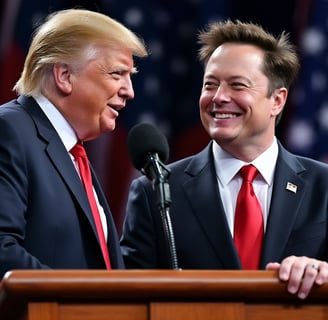What Could The Coming Department Of Government Efficiency Target To Cut?
In a world increasingly concerned with fiscal responsibility and the efficient use of taxpayer dollars, the concept of a "Department of Government Efficiency" (DOGE) has emerged as a beacon of hope for those looking to streamline government operations
LB
11/9/20244 min read


In a world increasingly concerned with fiscal responsibility and the efficient use of taxpayer dollars, the concept of a "Department of Government Efficiency" (DOGE) has emerged as a beacon of hope for those looking to streamline government operations. With Donald Trump allegedly at the helm of this initiative, the focus is not just on reducing government waste but also on reevaluating the very structure of federal entities. Here's a detailed exploration of what such a department might target for cuts or reforms:
Unconstitutional Government Agencies
1. Federal Reserve System:
While not directly part of the federal government, its independence and broad monetary policy authority have long been debated. Critics argue that the Federal Reserve's actions can sometimes overstep constitutional boundaries by exerting too much influence over economic policy without direct democratic oversight.
2. Department of Education:
Established relatively recently in 1979, some argue that education should remain a state and local issue, questioning whether the federal role in education is constitutionally justified or efficient.
3. Environmental Protection Agency (EPA):
While environmental protection is crucial, the EPA's broad regulatory powers might be scrutinized for potentially infringing on states' rights or private property rights, which some see as an overreach beyond the scope intended by the Constitution.
Foreign Aid and International Programs
1. Foreign Aid:
The U.S. government allocates billions in foreign aid annually. A drastic cut or complete cessation would be a significant move towards reducing federal spending. Proponents argue that this money could be better reinvested domestically or that aid should be drastically reformed to ensure it aligns with U.S. strategic interests.
2. Department of State's Global Programs:
Programs that fund international development, peacekeeping, and other non-defense related international engagements could be on the chopping block, with the argument that domestic issues should take precedence.
IRS and Taxation Reforms
1. IRS Workforce Reduction:
The hiring of tens of thousands of new IRS agents has been a point of contention. Reducing this workforce, particularly if aimed at simplifying the tax code or reducing enforcement on small businesses and individuals, could be seen as promoting economic freedom and reducing government overreach.
2. Tax Code Simplification:
Alongside reducing personnel, a simplification of the tax code could reduce the need for such a large IRS, focusing instead on a system that's easier to administer and comply with.
Addressing Bloated Government Agencies
1. Health and Human Services (HHS):
With numerous programs that overlap or compete with private sector offerings, there's potential for consolidation or privatization of services like Medicare and Medicaid, which could reduce bureaucratic overhead.
2. Department of Defense:
Despite being essential for national security, inefficiencies like redundant military bases, outdated procurement processes, and overlapping research initiatives could be streamlined.
3. Social Security Administration (SSA):
While Social Security is a cornerstone of American social welfare, its administration could be made more efficient. Automation and better fraud detection could save billions, though this must be balanced with maintaining benefits.
Unnecessary Government Bureaucracies
1. Amtrak:
Often discussed as a candidate for privatization, Amtrak's operational inefficiencies and its reliance on government subsidies could be addressed by transitioning to private ownership or reducing its scope.
2. The U.S. Postal Service (USPS):
With the rise of digital communication and private shipping companies, the USPS could be streamlined, potentially by reducing service levels or privatizing certain aspects.
3. Federal Housing Administration (FHA):
The FHA's role in the housing market could be reconsidered, especially if private insurance and loan entities are seen as viable alternatives for supporting homeownership.
Technological and Operational Efficiencies
1. Digital Transformation:
Across all agencies, moving towards fully digital operations could significantly cut costs. This involves everything from electronic filing for taxes to telemedicine in Veterans Affairs.
2. Reduction of Physical Footprint:
Selling off or repurposing underused federal properties could reduce maintenance costs. This includes military bases, office buildings, and even embassies abroad.
3. Procurement Overhaul:
Government procurement is notorious for being slow and expensive. Implementing best practices from the private sector or using technology to streamline the process could save substantial amounts.
Legislative and Regulatory Reforms
1. Regulatory Review:
A systematic review of regulations across all agencies could eliminate outdated or overly burdensome rules, thereby reducing compliance costs for businesses and individuals.
2. Repeal of Duplicative Programs:
The Government Accountability Office (GAO) has annually reported on federal programs with overlapping goals. Targeting these could lead to significant savings, as highlighted by reports from 2011 onwards.
Political and Economic Considerations
The push for efficiency must navigate a complex political landscape.
Economic Impact: While efficiency cuts could save money, the immediate economic impact, like job losses, must be managed carefully to avoid negative economic ripple effects.
Public Perception: Programs like Social Security and Medicare are deeply embedded in the social fabric. Any reform must be communicated effectively to avoid public backlash.
Innovation in Government: Instead of just cutting, there could be an emphasis on innovation, where government agencies adopt new technologies or methods to serve better at a lower cost.
Conclusion
The creation of a "Department of Government Efficiency" could be a transformative step towards reducing federal spending and enhancing operational effectiveness. However, the challenge lies in ensuring that these cuts do not undermine essential services or compromise national interests. The initiative would need to balance between the pursuit of efficiency and the maintenance of a government capable of serving its citizens comprehensively.
-LB-
Other Articles You Might Like:
